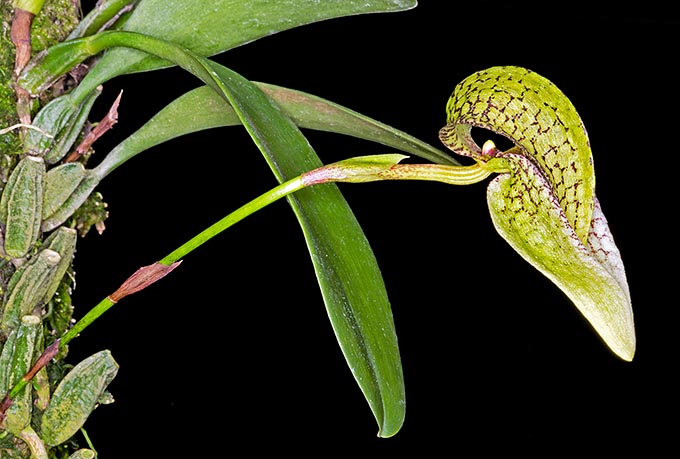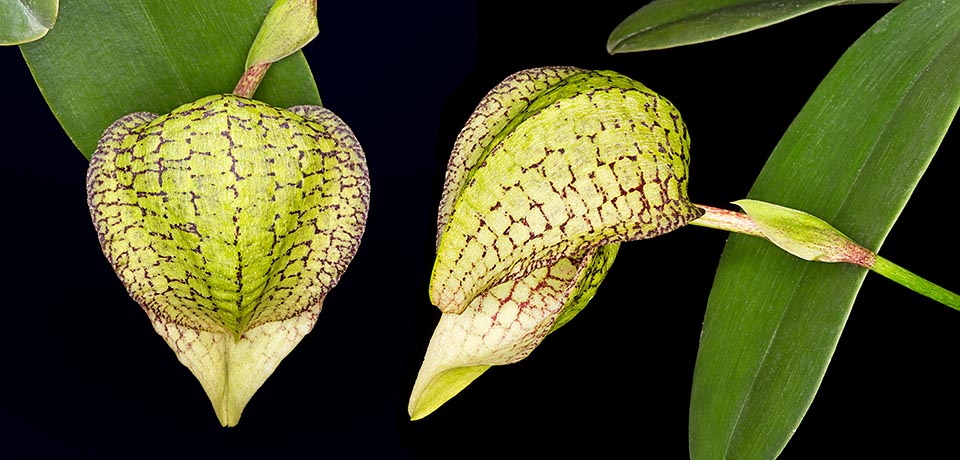Family : Orchidaceae

Text © Pietro Puccio

English translation by Mario Beltramini

Bulbophyllum arfakianum is a slow-growing New Guinea epiphyte © Giuseppe Mazza
The species is native to Western New Guinea where it grows as epiphyte on the trees of the pluvial forests of the Arfak Mountains at low altitudes.
The name of the genus is the combination of the Greek substantives “βολβός” (bolbos) = bulb and “φύλλον” (phyllon) = leaf, with reference to the leaves growing at the apex of the pseudobulbs; the name of the species is the Lain adjective “arfakianus, a, um” = for the Arfak Mountains, in Western New Gunea.
Common names: Arfak Mountain Bulbophyllum (English).
The Bulbophyllum arfakianum Kraenzl. (1904) is a slow-growing epiphytic species with ovoid sessile pseudobulbs, grooved, spaced of about 2,5 cm on a creeping rhizome, 2,5-3 cm tall, carrying at the apex one single oblong leaf, coriaceous, 4,5-9 cm long and 2,5-3 cm broad, of dark green colour on the upper page, paler below. Lateral inflorescence from the base of the pseudobulb, about 14 cm long, carrying one single green flower with reddish brown macules, about 5 cm long, with oblong dorsal sepal with pointed apex bent forward, about 4 cm long and 2 cm broad, falcate lateral sepals converging at the apex, about 3,5 cm long, narrower, 0,5 cm long petals and about 0,4 cm long labellum. It reproduces by seed, in vitro, micropropagation and division, with each section provided of at least 3-4 pseudobulbs.
Species rare in the wild and in cultivation with the characteristic long-lasting flowers, requires a very luminous position, but not in direct sun, in particular that of the central hours of the day, medium-high temperatures, 20-32 °C, in summer, 16-26 °C in winter, and constant high humidity, 70-85%, with air always moving.

The opening odd green flower with brown-reddish drawings, seen from front and side.It’s a protected species, rare in nature and in cultvation © Giuseppe Mazza
Watering must be frequent during the vegetative period, but allowing the roots to dry up, more spaced in winter, but without ever letting the substratum to dry up completely. For the watering and the nebulisations is to be used rain water, by reverse osmosis or demineralised; the fertilizations duly distributed in function to the vegetative status of the plant and alternate, in way to avoid salts accumulaton at the roots, are to be preferably done with hydro soluble balanced products, with microelements, at ¼ of the dosage suggested on the package. It is to be mounted on bark, trunks, rafts of cork or of arborescent ferns roots or placed in baskets with much draining and aerated compost, which may be formed by medium sliced bark fragments. The repottings are to be done when strictly necessary at the vegetative restart, signalled by the appearance of the new roots.
The species is reported in the appendix II of the CITES (species whose trade is ruled at international level).
Synonyms: Bulbophyllum fraudulentum Garay, Hamer & Siegerist (1996); Hyalosema arfakianum (Kraenzl.) Rysy (2002); Hyalosema fraudulentum (Garay, Hamer & Siegerist) Rysy (2002).
